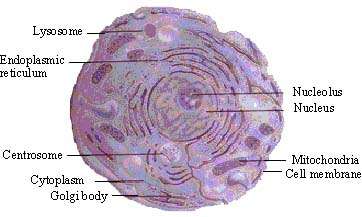|
PinkMonkey Online Study Guide-Biology
CHAPTER 3 : CELL - THE BASIC UNIT OF LIFE
3.0 Introduction
A cell is a microscopic, structural and functional unit
of living organisms capable of independent existence. (e.g. Ameba). All
living things are composed of cells. Some functioning cells come together
to form a tissue and tissues collectively form organs. In more complex
living organisms, organs work together for the purpose of survival as
system. However, in all living organisms, the cell is a functional unit
and all of biology revolves around the activity of the cell.

Figure 3.1 Animal Cell
The study of cell is impossible without the microscope.
The first simple microscope was prepared by Anton Van Leewenhoek
(1632-1723) who studied the structure of bacteria, protozoa,
spermatozoa, red blood cells etc. The word ‘cell’ was first
coined by Robert Hooke in 1665 to designate the empty
honey-comb like structures viewed in a thin section of bottle
cork which he examined. He was impressed by the microscopic
compartments in the cork as they reminded him of rooms in a
monastery which are known as cells. He therefore referred to
the units as cells. In 1838, the German botanist Matthios
Schleiden proposed that all the plants are made up of plant
cells. Then in 1839, his colleague, the anatomist Theodore
Schwann studied and concluded that all animals are also
composed of animal cells. Schwann and Schleiden studied a wide
variety of plant and animal tissues and proposed the "cell
theory" in 1839. It stated that "all organisms are
composed of cells." But still the real nature of a cell
was in doubt. Cell theory was again rewritten by Rudolf Virchow
in 1858.
In his theory he said that all living things are made up of cells and that all cells arise from pre-existing cells. It was German biologist Schulze who found in 1861 that the cells are not empty as were seen by Hooke but contain a ‘stuff’ of life called protoplasm.
During the 1950s scientists developed the concept
that all organisms may be classified as prokaryotes or eukaryotes.
For example, in prokaryotic cells, there is no nucleus; eukaryotic
cells have a nucleus. Another important difference between prokaryotes
and eukaryotes is that the prokaryotic cell does not have any intracellular
components. Bacteria and blue- green algae come under the prokaryotic
group, and protozoa, fungi, animals, and plants come under the eukaryotic
group.
|
Table of Contents 3.0 Introduction
3.1 Modern cell theory
3.2
Structure of cell
3.3
Movement through the plasma membrane
Chapter 4
|